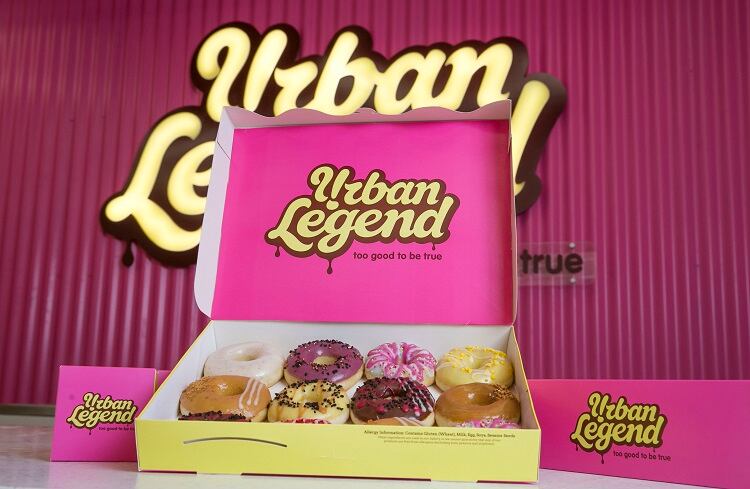The sweet bakery category is thought to be one of the unhealthiest on shelf, making healthier reformulation – or innovation – no mean feat.
It also makes products within sweet bakery a target for better-for-you entrepreneurs.
This was the case for start-up Believe in Science, which decided to tackle doughnuts for their ‘very few redeeming features’, recalled founder Anthony Fletcher. “The doughnut also has a unique place in the consumer’s mind. It is a very, very indulgent product.”
The result is Urban Legend, a brand of non-HFSS (high in fat, sugar and salt) doughnuts selling in its own bricks-and-mortar stores as well as across national retailers in the UK.
Although not an easy product to ‘crack’, Fletcher claims to have done it with the help of reformulation strategies, patented technology, and consumer insights – on-tap.
Not all ‘healthy indulgence’ products survive, does the trend have potential?
From a health perspective, better-for-you alternatives to traditionally indulgent products are a no-brainer. Eating too much sodium, sugar and fatty food is known to increase risk of non-communicable diseases, including the single biggest killer, cardiovascular disease.
But in practice, it can be tough. Not all better-for-you products last the distance on shelf, with Nestlé’s sugar reduced Milkybar Wowsomes an obvious example. After less than two years on the market, the chocolate bars were withdrawn. The Wowsomes example is far from the only one.
As to whether consumers want healthier versions of their favourite treats, Fletcher believes it comes does to the quality of the product. “In the UK, most of Coca-Cola’s carbonate sales now come from zero sugar or low sugar drinks. That was very different 20 or 30 years ago. I think if you can give the consumer an indulgent product and earn their trust…then yes they do want it.
“The issue is that many categories haven’t yet cracked how to present a genuinely indulgent product.”
There is real market potential for healthy indulgence products, contends the Believe in Science CEO. And not just in the UK. “The most universal insights we’ve seen is that retailers face a dilemma: they know [better-for-you products] sell very well. But there’s a limit to how many healthier products they can sell,” he told the audience at FoodNavigator’s Positive Nutrition Digital Summit yesterday.
Ultimately, with incoming junk food regulations and a move to more responsible practices, retailers know they must make progress. They’re looking for the best of both worlds: products that comply with legislation and responsible practices, but that also sell. This is what Fletcher says he’s created in Urban Legend.
What’s so tough about reinventing the wheel (or in this case, doughnut)?
Before diving into the challenges, a brief point on the advantages of tackling the doughnut. Urban Legend was not a traditional doughnut brand that sought to reformulate. Instead, Fletcher wanted to start from scratch and create a brand-new product: an HFSS compliant doughnut.

“The big advantage was starting from scratch,” explained Fletcher. “That allowed us to rethink both formulation and process, how to remove large amounts of all that sugar, all that fat, all that sodium – which was surprisingly difficult to get out of the product – as well as getting the protein and fibre in.”
And because Believe in Science is a start-up, rather than a food incumbent, it felt the freedom to iterate the product as it scaled.
The result is a doughnut with 65% less fat, 30% less sugar and 30% fewer calories compared with iced and filled branded competitors. “It’s not easy to make a doughnut that tastes like Krispy Kreme with as many calories as a glass of milk, let alone HFSS compliant and enriched with protein and fibres, and no artificial colours.”
Fletcher is convinced healthier doughnuts haven’t previously been ‘cracked’ due to their inherent sugar and fat content – both of which serve functional purposes. The CEO estimates there could be up to 30 reasons sugar and fat make their way into the formulation, so the challenge lies in filling those functionality gaps, without the nasties.
Ultimately, saturated fat was the most challenging nutrient to limit in Urban Legend’s doughnuts. The final formulation has 70% less saturated fat compared to branded alternatives.
“The problem with saturated fat is it’s what the product is fried in, it’s what coats the product. It’s what changes the length and behaviour of the gluten strands, it stabilises the bubbles in the product, it makes the icing resistant [so it can] lie on top of a what is a relatively moist product, it dissolves in the mouth, it is a great flavour carrier.”
The secret to healthier doughnuts. Well, what Urban Legend will reveal…
There is not just one secret to creating healthier doughnuts for the mass market, but at least three: patented cooking technology, reformulation ingredients, and instant consumer feedback.
On the ingredients side of things, the company is using sugar replacers discovered in melons, pears, roots and leaves, and alternatives to artificial colours such as extracts from flowers, plants and vegetables. The yellow colouring is sourced from safflower and the red colouring, from beetroot.
Limiting a significant portion of saturated fat from the product came down to technology, rather that pure play ingredients. The company is using a patented manufacturing process based on novel starch and protein technologies that allow dough to be ‘set’ by a beam of steam, rather than the conventional frying method, we were previously told.
“By changing the nature of the starch and proteins used, you can achieve that doughy texture,” Fletcher elaborated. Replicating the taste, texture, and smell of a doughnut has been achieved by other tech-savvy approaches. “For instance, we deposit a micro layer of fat on the outside of the doughnut, retaining the taste and texture of a deep fat product with barely any saturated fat being added to the product.”

Consumer feedback has also proved essential to the product’s success, suggested Fletcher, who previously headed up better-for-you snacks brand Graze (now owned by Unilever). Taking an iterative approach to brand and product development, and learning from direct-to-consumer channel data, was one of the ‘fundamental’ ideas behind the start-up.
When do people eat doughnuts?
According to Believe in Science CEO Anthony Fletcher, doughnuts are best suited to a ‘shared moment’. Some consumers may buy a single doughnut for immediate consumption, but most sales come from sharing occasions, we were told.
This is why Urban Legend is diversifying its sales channels, selling into both branded pop-up shops and via listings with national retailers. “The idea behind the pop-up shop was to be able to have real conversations with consumers and shoppers. It can be difficult in grocery stores to find a shopper in that mindset, but the beauty of a pop-up shop is that people walk in and they’re happy to talk.”
This allowed Urban Legend to ‘very quickly’ establish who its core consumer is (for the most part, mothers buying healthier treats for their children and often themselves). What has taken longer is getting the branding and messaging on point, to appeal to a grocery shopper in a rush.
In this way, Urban Legend sets itself apart from its food major competitors. “One of the flaws with FMCGs is when it comes to innovation, it’s very hard to get it right in one go. But if you can iterate and learn from real consumers…I believe your chances of success grow.”
Missed any of FoodNavigator’s Positive Nutrition Digital Summit 2024? Don’t worry, you can still access all of our sessions and handouts, which will be available on-demand for the next 90 days. Click here to register for free.




